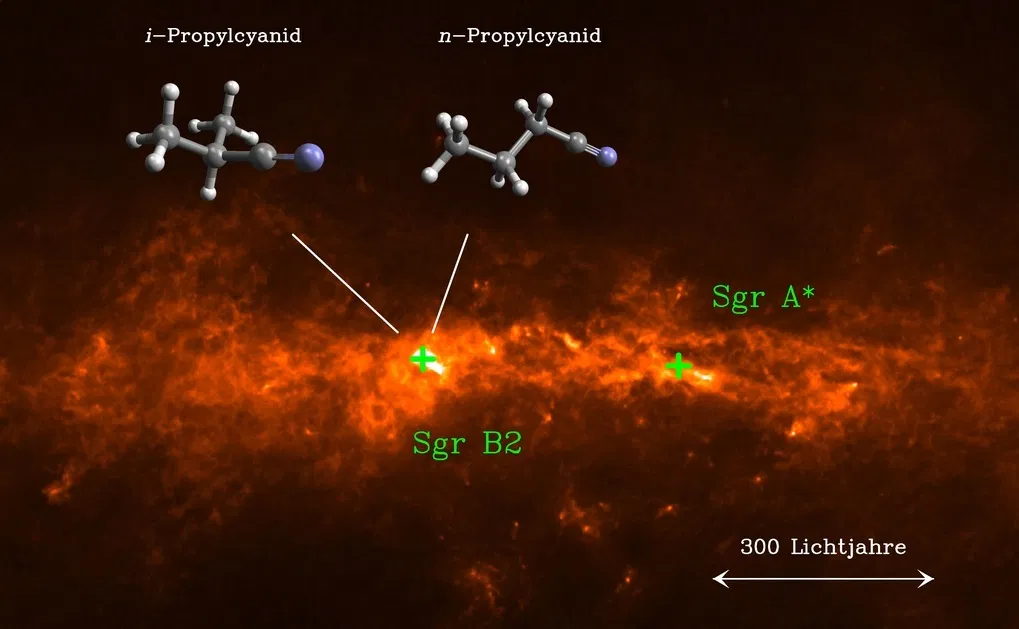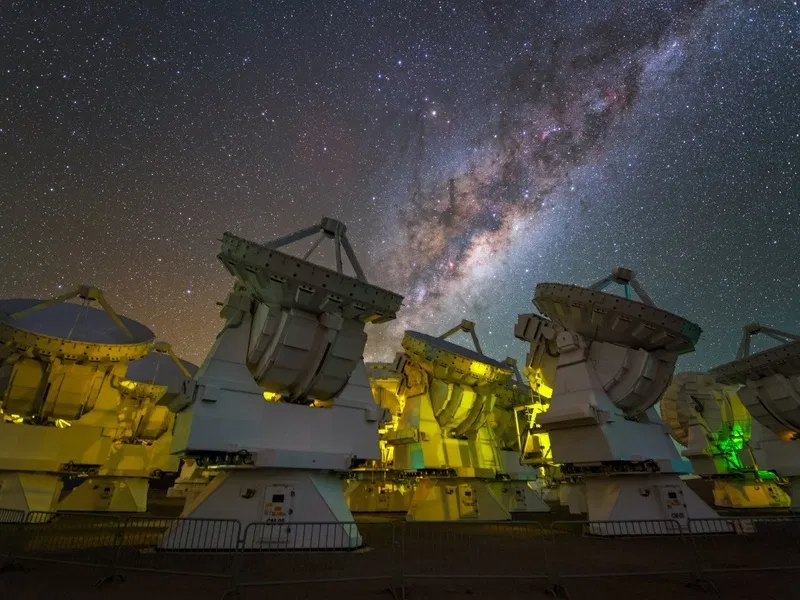Outline
Molecule discovery suggests life could have started in space
An isopropyl cyanide molecule, the largest and most complex molecule to date found in interstellar space, has been discovered by the Atacama array in Chile. The discovery was located in a star-forming gas cloud. Dust in the cloud becomes heated, and chemical isopropyl-cyanidereactions on dust particles can give rise to complex molecules. Hydrogen-rich organic molecules, similar to those essential to life on Earth, are numerous in dust clouds that give birth to new stars.
The presence of isopropyl cyanide suggests the possibility that the building blocks of life could be common in interstellar dust clouds. A total of around 180 molecules have been identified in interstellar space. It is thought that amino acid molecules, the constituents of protein, may also be produced in dust clouds in interstellar space. Amino acids have been found in meteorites suggesting that they too originated from interstellar space.


Organic Molecules in InterStellar Clouds:
The 3.4 um absorption feature in the spectrum of several infrared sources (Wickramasinghe and Allen, 1981; Willner and Pipher, 1982) indicates the presence of organic molecules in the interstellar medium. Several identifications were proposed such as Hydrogenated Amorphous Carbon (Duley and Williams, 1983), and residues produced by proton bombardment of ice mixtures (Strazzulla et al., 1984).
We show how an organic grain mantle is produced in molecular cloud. It is estimated that half of the volatile molecules containing O, C, N are converted to organics in the lifetime of an average cloud. The spectrum of an organic material made by laboratory simulation of this process closely resembles the N.I.R. spectrum of the galactic center source IRS7. We estmate the extinction towards the G.C.., finding a value which agrres well with other determinations.
A two-year survey of enormous interstellar dust clouds has turned up eight organicmolecules in two different regions of space. One is a stellar nursery awash inlight while the other is a cold, starless void.
The finding detailed in the current issue of Astrophysical Journal,supports other recent studies suggesting molecules important for life commonlyform in the gas and dust clouds that condense to form stars and planets.
Themolecules were discovered using the Robert C. Byrd Green Bank Telescope (GBT),a large radio telescope located in West Virginia.
"Findingeight [organic] molecules in the space of two years is quite remarkable,"said study leader Jan Hollis of NASA Goddard Space Flight Cente
Life Molecules:
The newly discovered molecules are made up of 6 to 11 atoms each and are classified asorganic because they contain carbon.
Five of the molecules were discovered in Sagittarius B2(N), a star-forming dust cloudlocated 26,000 light-years from Earthnear the center of the MilkyWay Galaxy. This stellar nursery is the largest known repository of complexinterstellar molecules.
The other three molecules were found in the Taurus Molecular Cloud (TMC-1), located only 450light-years away. TMC-1 is starless; it is cold and dark and has a temperatureof only 10 degrees above absolute zero.
"Thediscovery of these large organic molecules in the coldest regions of theinterstellar medium has certainly changed the belief that large organicmolecules would only have their origins in hot molecular cores," saidstudy team member Anthony Remijan of the National Radio Astronomy Observatory(NRAO). "It has forced us to rethink the paradigms of interstellarchemistry."
Just becausea molecule is organic does not mean that it is made by living things. In fact,many of the newly spotted molecules are poisonous to organisms on Earth, Hollissaid. But one of the molecules found in Sagittarius B2(N), called acetamide,contains a type of chemical bond important for linking together amino acids,the molecular building blocks of proteins.
Made up of 9 atoms, acetamide "is the largest molecule found in space that has thatbond,"
Spacetumbleweeds:
The moleculesare thought to form by two main mechanisms. In the first, simple chemicalreactions add an atom to a molecule that is stuck to the surface of a dustgrain afloat in space. The second method involves chemical reactions betweenneutral molecules and highly reactive molecules called radicals.
Once formed, the molecules are shaken loose from their dust-grain homes by rapidlymoving shockwaves. As the freed molecules tumble end-over-end in space, they can emitor absorb radiation at precise radio frequencies unique to each type ofmolecule. Astronomers identify the molecules based on these radio frequencies.
Within a dust cloud, thousands of billions of molecules undergo the same types ofrotation, emitting and absorbing the same radio frequencies. The end result isa signal strong enough to be detected by instruments on Earth.
The new found molecules bring the total number of biologically-relevant moleculesfound in interstellar space to 141. Scientists have previously found benzene,a ring-shaped carbon molecule important for life on Earth, around stars andintact amino acids in meteorites that have crash-landedon Earth.
Even morecomplex molecular creations might be possible in space, experiments suggest. Inone study, scientists simulated deep space conditions in the laboratory andcreated small structures resembling cell wallsin living organisms.
A casefor extraterrestrial life:
Taken together, the findings suggest that the chemical ingredients necessary for lifebegan taking shape long before our planet was formed.
Many scientists now accept the notion that ancient meteorites and comets helpedjumpstart life on our planet by bringing a significant amount of water, organicmolecules and even amino acids to early Earth.
Scientists now think those imprisoned organic molecules were likely created in the massivedust and gas clouds that eventually coalescedinto planets and stars, comets and meteorites. Dust clouds are thought to formwhen events such as novasand supernovascaused chemical elements and molecules created during thermonuclear reactionsinside stars to be ejected into space.
Hollis sayshis team plans to keep using the Green Bank Telescope to continue searching forother biologically-significant molecules.


